
Açiq mənbələrdən foto.
Ayaz Mutalibov
(from the book “Karabakh - Black Garden”)
In January-February 1992, thanks to my efforts, the issue of transferring the property of the former 4th Army and part of the warships of the Caspian Flotilla after negotiations with the former leadership of the USSR Ministry of Defense was decided.
The Popular Front opposed this, demanding to exclude any, even conditional, dependence of Azerbaijan on Russia, the help of which could become real for Azerbaijan.
I have already said that on February 14, 1992 in Minsk at the next meeting of the heads of state I did not sign an agreement on the entry of the Azerbaijani army into the system of the CIS High Command.
Prior to this meeting, the issue of our joining the CIS High Command was submitted for discussion by the Supreme Council of the republic. It was initiated by me, and I proposed to give the appropriate consent.
Azerbaijan’s agreement with the proposal of Moscow would mean the possibility of subsequently using its potential role in the Karabakh settlement, but failure - on the contrary - created additional difficulties for us.
The importance of this document for Moscow was so significant that the leadership of the Russian Federation, if we agreed with it, was obliged to disband the 366th motorized rifle regiment stationed in Stepanakert.
I remember how at the time of discussion of this issue in the Supreme Council of the Republic B.N. called me Yeltsin. After talking with him on the phone, I then informed the deputies about this conversation.
I said that the President of Russia conveyed to the deputies his promise to disband the 366th regiment and asked the Supreme Council of the republic to make a positive decision on the issue of signing an agreement on the High Command by Azerbaijan.
Alas, both Yeltsin’s appeal and my request didn’t have any effect on the deputies, they never gave their consent.
Armenia signed this agreement and received the support of Moscow.
To what Mutalibov said, we’ll add that the failure to agree on the transfer of military equipment to the 4th Army to Azerbaijan occurred due to the fault of the last Minister of Defense of the USSR Yevgeny Shaposhnikov, who insisted that it was necessary to have a single command of the CIS troops.
366th regiment
The ominous role of this unit in the Khojaly tragedy is well known. Already in the first days after the events in the Russian press, much was said and written about this. Here are just two of those publications.
“The commander of the first battalion once agreed with the commander of the artillery battalion: this is how they will go on combat duty, begin to withdraw equipment and, at their own risk, break out of Karabakh. The regiment learned about this and removed them from duty. But the soldiers still run. Three to five people a day. Although it is very dangerous. In our memory, two gave a fight. And a few days later a message came: between Khojaly and Askeran, the corpse lies — take it. Gorokhov Alexander from the artillery division turned out to be, his second comrade was never found.
Once eleven people ran away at once. We walked along the road with a white flag. In Mardakert region, fire was opened on them. Only six got to Agdam alive. The Armenians caught two more fugitives and exchanged them back to the regiment — for 800 liters of diesel fuel.
From October at night, they began to leave the regiment on combat duty. But only officers and trusted old-timers, mostly driver mechanics, sometimes gunners. On infantry fighting vehicles, tanks, they took guns with them. Drunk came back in the morning, and all the ammunition was shot. The soldiers said that at first they drank with the militants, and then they went to the Azerbaijani villages at their direction and shot ... This is such neutrality of the CIS army. ”
Vadim Belykh, Izvestia, March 14, 1992
And this is an article published in the newspaper of the 23rd division, which included the 366th regiment. However, the entire circulation of the “seditious” issue was ordered to be destroyed by order of Lieutenant General I. Ohanyan (deputy commander of the Transcaucasian Military District). The only copy from which this reprint was made miraculously survived. The journalist Viktor Shevchenko, in the Soviet Warrior division newspaper, in an article entitled “Export - 366” describes how paratroopers from Ganja removed equipment and personnel from the regiment from Karabakh (with abbreviations).
“Under the awning of agricultural warehouses, the valiant 366th motorized rifle regiment raged wildly. Drunken soldiers and officers, lounging by the fires, sang songs in the insole. A drunken officer wife was tearfully killing herself over a missing bundle of dollars. They pacified her, they built a soldier for a search, convincing them to return blood stuff to the miserable. “We have suffered such a thing here,” the drooling lieutenant proved to the paratrooper, “which you never dreamed of. What do you reproach us with money, corruption? If you had lived in Stepan for about a year, you would have sung differently! Here is big politics, it’s better not to meddle in it. ”
What central newspapers are pathetic: "The 366th motorized rifle regiment leaves Stepanakert, fighting off bullets from militants and lies." I don’t know what about the lie, but only the paratroopers fought off bullets. The Armenians escorted the third battalion of this regiment with batteries of cognac bottles, a plentiful snack, and fraternal hugs. “Sufferers” were laid tables right on the hoods of cars, they gave them meat for barbecue, stocks for the night. For what? Perhaps the answer to this was concealed to the top of the soldiers' stuffed bags stuffed with money, taken away by motorized riflemen to “the mainland?” Or - in voluminous purses of officer wives, bursting with bundles of currency. Not for nothing was the assistant commander of the 366th regiment for work with personnel openly confessing: “I know that in Vaziani prison cells have long been ready for us ...
And the paratroopers did not know at all that the whole motorized rifle battalion was capable of “not noticing” the disappearance of its own weapons, advanced equipment, and ammunition. For five hours in a row, the landing party was waiting on the armor for a group of generals led by Ohanyan, who urgently needed to link “some issues” with Stepanakert’s leadership. During this time, the commander of the 366th lieutenant colonel Yuri Zarvigorov managed to visit the second battalion. By the return of the generals, not a single combat vehicle, not a single rifle barrel remained in the location of the battalion.
What’s the battalion ?! Hundreds of paratroopers are ready to testify before anyone the shameful surrender by the 366th Regiment of all their weapons and equipment into the hands of militants. This event was presented as an "organized exit", which "provide" paratroopers. In fact, it turned out not a way out, but the removal of the decomposed community that had completely lost its idea of discipline and military honor. Of the one hundred and fifty units of the regiment’s armored vehicles, less than a third were evacuated by airborne assault. Eight ultramodern tanks, about a hundred combat vehicles, self-propelled anti-aircraft mounts, howitzers and ammunition, three quarters of small arms remained the efforts of the regiment among people far from humanism.
I will not describe the procedure for seizing weapons from a half-drunken regiment, the behavior of motorized rifle commanders, terrible suspicions, along with discoveries confirming them. Outside of this story there will be a huge number of egregious facts that the journalist is not entitled to announce. They say that competent authorities are working on them, an investigation has been appointed. Personally, I do not believe in the success of lawyers, but I wish them good luck and protection from politicians - they will certainly need it.
According to the leadership of the operation from the Airborne Forces, if our group had been granted operational independence, the predominant part of the armament and equipment of the 366th regiment would have been saved. The senior grouping officer, Y. Naumov, repeatedly offered the district general real options for a hidden march into the neutral zone. Even when the loss of the bulk of the armored vehicles became apparent, there was the possibility of leaving one battalion on the technique ahead of the calculated mountain route. According to the situation at that time, the militants did not have time to block the track or organize serious resistance. The group would have simply dared insignificant barriers, having left in a safe area in a maximum of six hours.
The entire burden of the so-called withdrawal fell on the landing party. On the night of March 3rd, the parachute company of “senior lieutenant Igor Yulpatov repelled the attacks of the militants for six hours. The steep height south of the Mehdishen village was stained with the blood of the company’s favorite - Sergeant Andrei Ruder, the best junior paratrooper commander.
The height was besieged by a fairly experienced, well-trained and well-knowing enemy. The paratroopers, who took up a circular defense on a tiny platform of the peak, seemed to him a tidbit. Therefore, probably, he acted so impudently - he approached a distance of up to forty meters, opened fire only for sure. The militants contributed to pitch darkness, occasionally illuminated by illuminating missiles. They sought to take the company in a vise, meddled on all sides, felt for its firing points, and studied defense. It is entirely conceivable that they needed a hostage to neutralize the landing by means of blackmail. In addition, the height was an unusually advantageous position prevailing over the plateau, from where any section of the defense of the group “got”.
But the parachute company is not a peaceful village with unarmed inhabitants. A powerful rebuff cooled the immoderate fervor of the militants for a long time. The group urgently completed the evacuation of equipment of the 366th regiment».
How Armenians talk about massacres
The Armenian side has traditionally denied mass killings, but under the pressure of facts, they sometimes slip out or make half-confessions.
Vitaly Balasanyan (commander of the Askeran detachment)
From an interview with Regnum, 2007.
"Together with the Azerbaijani soldiers, we then collected the corpses of the dead and passed them into the hands of Azerbaijanis."
To this statement, the question arises: how could Balasanyan and other Armenians collect corpses and hand them over if they were in territory controlled by Azerbaijan?
From an interview with Balasanyan on Public TV of Armenia February 29, 2012
“Before the start of the Khojaly military operation, we invited civilians to leave the village.” According to him, the self-defense forces did everything possible to avoid casualties among the civilian population of Khojaly.
Speaking about the civilian casualties that still took place, Balasanyan noted that the deaths were mainly provoked by members of the Azerbaijani armed groups, who, being covered by civilians, fired from the crowd. "How could you not react to the shots of the uniformed people?" - said Balasanyan.
This is one of the few confessions of Armenians that they shot refugees retreating from Khojaly.
But now, perhaps, the most important recognition is not of anyone, but of Monte Melkonyan himself - a famous terrorist, one of the silt leaders of ASALA. His memoirs were published by Markkonyan’s brother Markar in the 2005 book “The Way of My Brother” published by the USA.
“Walking through the field, where women and children were scattered with broken arms and legs, heads cut off like dolls, Monte said to himself,“ No discipline! ” He understood that this was a response to the killings of Armenians in Sumgait, but he also understood that Azerbaijanis would avenge this. However, it was impossible to explain this to the bloodsuckers from the Arabo and Aramo detachments.
After the events in Khojaly that shocked Monte, these fighters did not stop their actions, even in the name of saving the hostages of the Armenians.
All the demands of Monte to remove from Martuni and Karabakh the units of Arabo and Aramo clashed against the opposition of the leadership in Stepanakert.
The detachments of Arabo and Aramo even before Khojaly committed the same atrocities in the village of Garadaghly. After that, the atrocities began to spread among the soldiers like a virus. ”
Zhirair Libaridyan (in 1992, adviser to President L. Ter-Petrosyan on foreign policy)
“Something unacceptable was committed, something that led to mutilations and killings of Azerbaijani civilians by the Armenians in Karabakh. Armenians deny or do not give enough explanations in the same way as Azerbaijanis do with what has been committed against Armenian civilians in Sumgait, Baku and other cities of Azerbaijan. It would be more appropriate and useful for Azerbaijan to recognize the Armenian pogroms in Sumgait and other cities of Azerbaijan. However, the recognition of their mistake by the Armenians should not depend on the recognition of their mistake by the Azerbaijanis.
Why should we hope that others will recognize crimes committed against Armenians if we do not recognize a much smaller, but nonetheless, crime we committed against others?
February 19, 2014 Massachusetts, United States
Eyewitnesses of the tragedy:
Human Rights Center "Memorial"
Excerpts from the report on the events in Khojaly (March-May 1992).
«In some refugee groups were armed people from the garrison of the city. These refugees, walking along the “free corridor”, in the territory adjacent to the Agdam region of Azerbaijan, were fired upon, as a result of which many people died. The surviving refugees scattered. Runners stumbled upon Armenian outposts and were bombarded. Some of the refugees still managed to get to Agdam; part, mainly women and children (it is impossible to establish the exact number), froze during wanderings in the mountains; part, according to the testimony of those who passed to Agdam, was captured at the villages of Pirjamal and Nakhichevanik.
There are testimonies of the residents of Khojaly that a number of prisoners were shot.
The bodies of the dead were scattered over a considerable area. Among the bodies captured at the place of mass death, the majority were women and elderly people, among the dead there were also children.
It can be assumed that the refugees from Khojaly, taking into account the impassability and physical capabilities of a mass of people, could reach the place of mass death in about 7-8 hours (the path along the highway running approximately parallel to the “free corridor” zone takes about 2 hours). Thus shelling refugees occurred already at dawn.
Within four days, about 200 bodies were taken to Agdam. Several dozen corpses had traces of mockery. Doctors of the Agdam city train fixed at least four scalped bodies, one body with a severed head.
NKR officials told Memorial observers that “with their permission 120-130 corpses were taken to Agdam.”
NKR officials and members of the Armenian armed forces explained the deaths of civilians in the “free corridor” zone by the fact that along with the refugees armed people left who fired at the Armenian outposts, causing return fire, as well as an attempt to break through the main Azerbaijani forces. Fighters of the Armenian post at close range opened fire on people coming from Khojaly.
(Video evidence of that by cameraman Agasi Hunn)
The fate of the inhabitants remaining in the city.
After the city was occupied by Armenian armed forces, about 300 civilians remained in it, including 86 Meskhetian Turks. On March 13, residents of Khojaly, including women and young girls, were still held hostage in Askeran. There is credible evidence that women were forcibly held in Askeran later than that date.
According to the testimonies of the captured and then exchanged residents and defenders of Khojaly, the men were beaten. There are indications, confirmed by the doctors of Baku and Agdam, about cases of rape, including minors.
During the military operation to capture the city of Khojaly, there were massive violence against the civilian population of this city. Information about the presence of a “free corridor” was not brought to the attention of the bulk of the Khojaly residents.
The massacre of civilians in the “free corridor” zone and surrounding area cannot be justified by any circumstances.
The seizure and retention of Khojaly’s civilians, including women, as "hostages" is in clear contradiction with the readiness declared by the NKR authorities to donate all the Khojaly civilians to the Azerbaijani side. The conditions of the "hostages" were extremely unsatisfactory; there was violence against the detained residents of Khojaly.
The residents of Khojaly were illegally deprived of their property, which was appropriated by the residents of Stepanakert and surrounding settlements. The NKR authorities legalized this appropriation of another's property, issuing warrants for the occupation of houses belonging to the fled and deported residents of Khojaly.
Soldiers of 366 motorized rifle regiment belonging to the CIS troops took part in the assault on Khojaly.
The Human Rights Center “Memorial” notes that during the assault on Khojaly, the actions of the Armenian armed forces of Nagorno-Karabakh against civilians of Khojaly are in flagrant conflict with the Geneva Convention, as well as with the following articles of the Universal Declaration of Human Rights (adopted by the UN General Assembly on 10.12. 1948):»
Victoria Ivleva
Employee of the newspaper Moscow News. The only journalist who saw the capture of the city with his own eyes and captured the next morning the shot women and children on the streets of Khojaly.
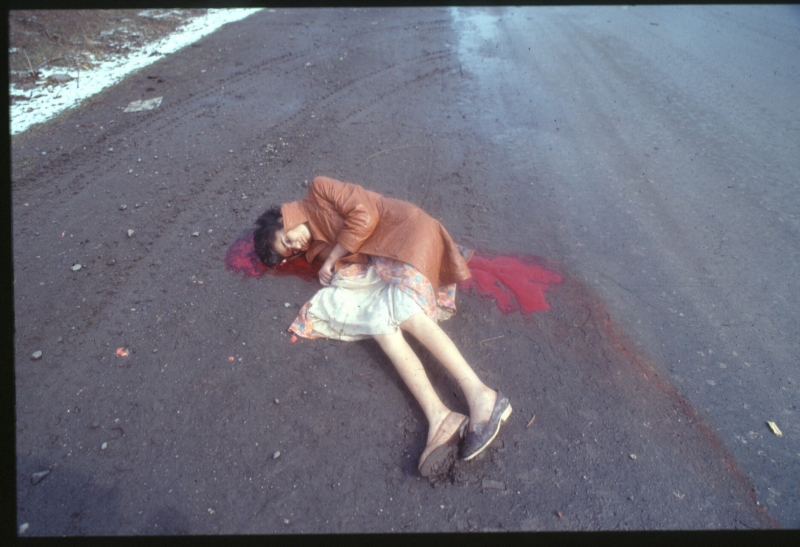
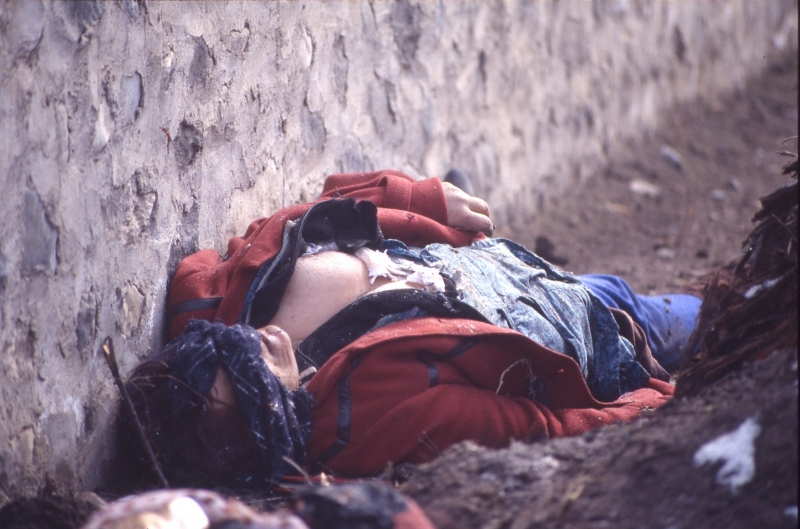
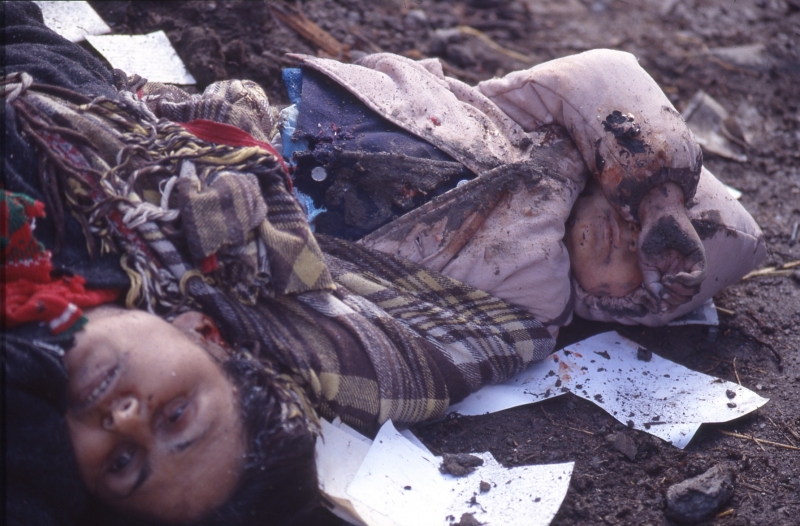
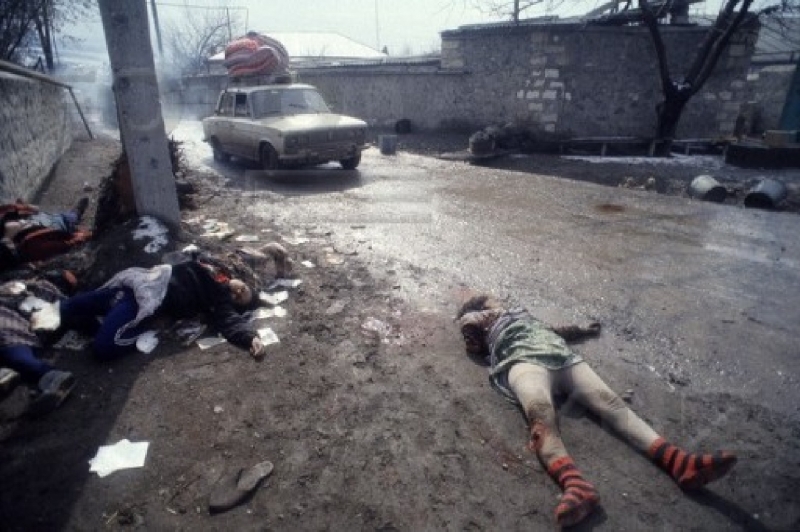
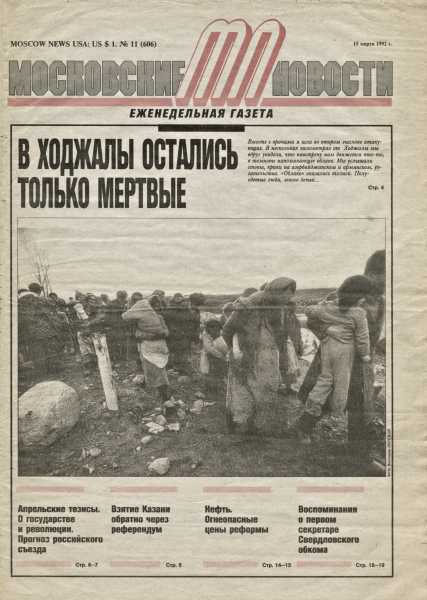
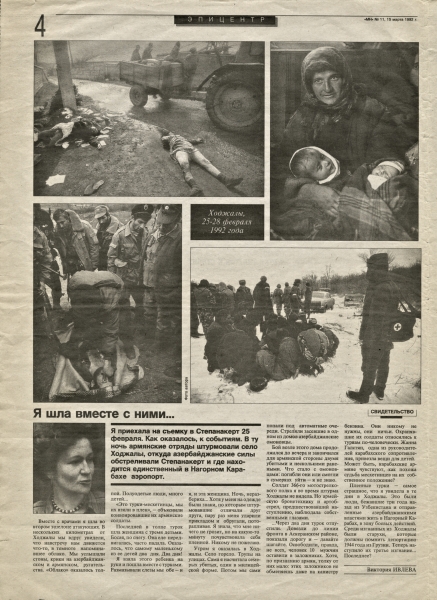
The story of Victoria İvleva in the documentary “Endless Corridor”
https://www.youtube.com/watch?v=2SL09t6jMv8
Attempt to return Khojaly
The fact that the Khojaly tragedy was largely the result of political games is no secret. Over time, more and more new facts become known that shed light on the causes of the tragedy, although much is not clear to this day. For example, about the role in these events of the 104th Russian Airborne Division, stationed in Ganja.
So, in early March, the soldiers of this division were preparing for a major military operation on the side of the Azerbaijani forces, which was supposed to end the liberation of Askeran, Khojaly and the villages around. However, this did not happen due to the fact that Ayaz Mutalibov did not stay in power.
Paradoxically, the fact that both the capture of Khojaly and its subsequent "liberation" were the result of a policy of the same force.
On February 26, Azerbaijan was punished because Mutalibov refused to sign an agreement on the creation of a unified command of the armed forces of the former USSR.
At a session of the Supreme Council of Azerbaijan on March 5, Mutalibov said that he regrets his refusal to sign the Tashkent agreement and that he will sign it in the near future. Moscow was informed about this, and it was decided to “free” Khojaly in order to preserve the power of Mutalibov, whose resignation became real.
So, the units of the 104th airborne division were assigned the combat mission of clearing the Askeran-Khojaly road. The operation was started, and before that, the armored vehicles of the 366th regiment were withdrawn from Khojaly and returned to Khankend.
The armored column of Russian paratroopers drove almost without a fight into Askeran and, further, into Khojaly, which was already empty by the morning of March 6. The military reports said: "On March 6, the Khojaly city and the village of Ballydzha in the Askeran region were unblocked and freed by the airborne forces stationed in the city of Ganja. One soldier died during the operation."
At the same time as the Russian paratroopers, the offensive was launched by units of the Azerbaijani army. On the morning of March 6, the largest military operation of the time, using infantry, armored vehicles, artillery and aviation (Mi-24 combat helicopters), began on the side of Agdam. The task of the operation was to bypass Askeran from the east and south and surround the group of Armenians in Askeran.
The operation was supposed to be lightning fast and complete in one to two days. However, which began successfully, the offensive was suddenly stopped. By that time, it became clear that Mutalibov did not stay in power. His desperate appeal on March 6 at the parliament meeting: “Give me three days and the situation will change!” - remained unheard of by deputies and the opposition.
The operation was blocked by the Russian military, no longer interested in its further success. Having practically taken possession of the Askeran village, armored vehicles did not go any further. Coordination with the forces of the Armed Forces of Azerbaijan has been violated. By the outcome of March 6, it became clear that the plan was planned, Azerbaijan failed, and again could not use the situation to its advantage.













Leave a review